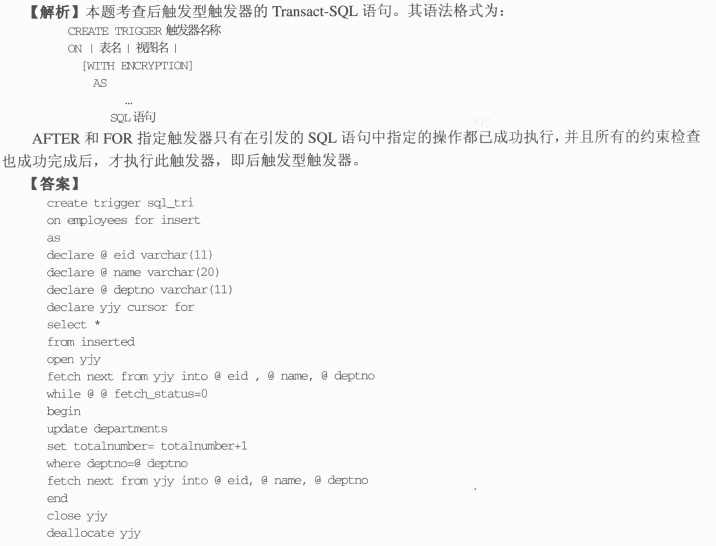Examine the structure of the EMPLOYEES, DEPARTMENTS, and TAX tables.EMPLOYEESNOT NULL, PrimaryEMPLOYEE_ID NUMBERKeyVARCHAR2EMP_NAME(30)VARCHAR2JOB_ID(20)SALARY NUMBERReferencesMGR_ID NUMBEREMPLOYEE_IDcolumnDEPARTMENT_ID NUMBER Foreign key toDEPARTMENT_IDc
题目
Examine the structure of the EMPLOYEES, DEPARTMENTS, and TAX tables.EMPLOYEESNOT NULL, PrimaryEMPLOYEE_ID NUMBERKeyVARCHAR2EMP_NAME(30)VARCHAR2JOB_ID(20)SALARY NUMBERReferencesMGR_ID NUMBEREMPLOYEE_IDcolumnDEPARTMENT_ID NUMBER Foreign key toDEPARTMENT_IDcolumn ofthe DEPARTMENTStableDEPARTMENTSNOT NULL,DEPARTMENT_ID NUMBERPrimary KeyVARCHAR2DEPARTMENT_NAME|30|ReferencesMGR_ID columnMGR_ID NUMBERof theEMPLOYEES tableTAXMIN_SALARY NUMBERMAX_SALARY NUMBERTAX_PERCENT NUMBERFor which situation would you use a nonequijoin query?()
A. To find the tax percentage for each of the employees.
B. To list the name, job id, and manager name for all the employees.
C. To find the name, salary, and department name of employees who are not working with Smith.
D. To find the number of employees working for the Administrative department and earning less then 4000.
E. To display name, salary, manager ID, and department name of all the employees, even if the employees do not have a department ID assigned.
相似考题
更多“Examine the structure of the EMPLOYEES, DEPARTMENTS, and TAX tables.EMPLOYEESNOT NULL, Pri ”相关问题
-
第1题:
I think the door is locked. But I'll go and ().A、check
B、examine
参考答案:A
-
第2题:
After __________ (examine) the lady, the doctor suggested that his back was badly hurt in the accident.参考答案:being examined
-
第3题:
检查
A.expect
B.except
C.excuse
D.examine
正确答案:D
-
第4题:
( 2 )现有如下两个关系模式:
Employees ( Eid , Name , DeptNO )
Departments ( DeptNO , DeptName , TotalNumber )
Employees 关系模式描述了职工编号、姓名和所在部门编号; Departments 关系模式描述了部门编号、名称和职工总人数。
请 按 SQL Serve r 所采用 的 Tansact — SQ L 语法格式编写实现具有功能的后触发型触发器 : 每当在Employee s表中插入一行数据时,相应部门的职工总人数就加 1 。( 10 分)
正确答案:
-
第5题:
已知关系模式R的全部属性集U={A,B,C,D,E,G}及函数依赖集:
F=(AB→C,C→A,BC→D,ACD→B,D→EG,BE→C,CG→BD,CE→AG}求属性集闭包(BD)+
(2) 现有如下两个关系模式:
Employees(Eid,Name,DeptNO)
Departments(DeptNO,DeptName,TotalNumber)
Employees关系模式描述了职工编号、姓名和所在部门编号;Departments关系模式描述了部门编号、名称和职工总
正确答案:(BD)+=ABCDEG X(O)=BD;由D→EG可知X(1) =BDEG;再由BE→C可知X(2)→BDEGC;又有CG→BDCE→AG可知X(3)=BDEGCA因为X(3)中包含了所有的属性集即有(BD)+=X(3)=ABCDEG T—C(TNO.CNO)主码(TNOCNO)外码TNOCNO S—C(SNOCNO成绩)主码(SNOCNO).外码SNOCNO (2) create trigger sql_tri on employees for
(BD)+=ABCDEG X(O)=BD;由D→EG可知X(1) =BDEG;再由BE→C,可知X(2)→BDEGC;又有CG→BD,CE→AG,可知X(3)=BDEGCA,因为X(3)中包含了所有的属性集,即有(BD)+=X(3)=ABCDEG T—C(TNO.CNO)主码(TNO,CNO),外码TNO,CNO S—C(SNO,CNO,成绩)主码(SNO,CNO).外码SNO,CNO (2) create trigger sql_tri on employees for 解析:本题考查了后触发器的Transact—SQL语句。其语法格式为:
CREATE TRIGGER触发器名称
0N |表名|视图名|
[WITH ENCRYPTION]
AS
SQL语句
AFTER和FOR,指定触发器只有在引发的SQL语句中指定的操作都已成功执行,并且所有的约束检查也成功完成后,才执行此触发器,即后触发型触发器。 -
第6题:
He rolled up his trouer leg to exhibit his wounded knee.A:spread
B:open
C:show
D:examine答案:C解析:本句意思:他卷起他的裤腿来显露受伤的膝盖。exhibit展示,显示。spread伸开,展开;open打开;show展示,出示;examine检查。
